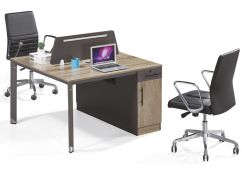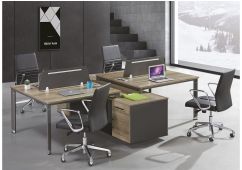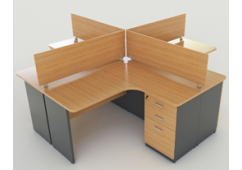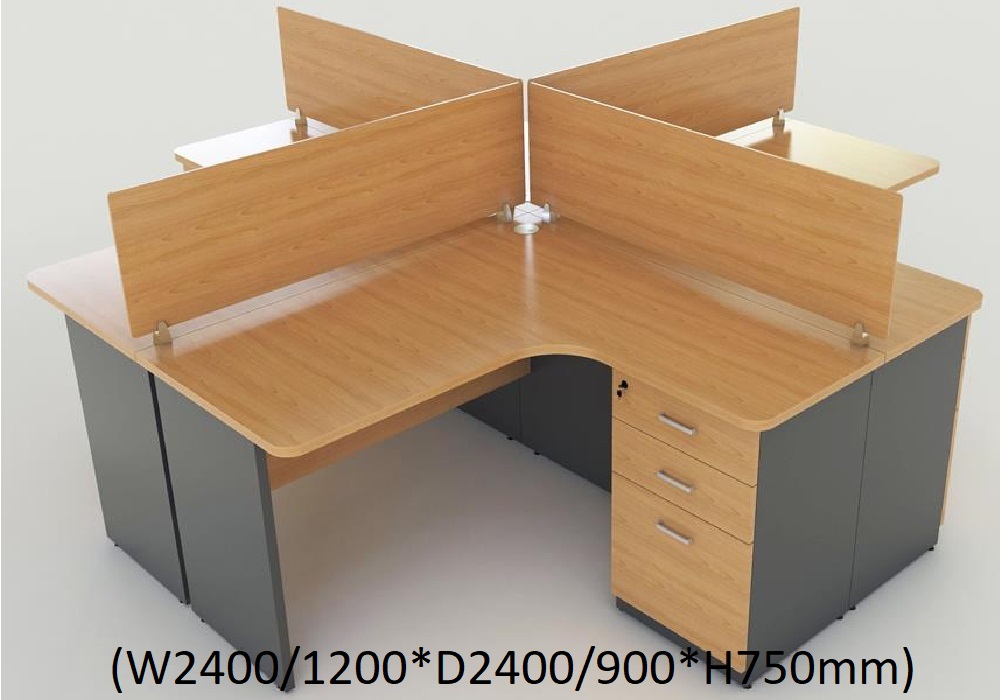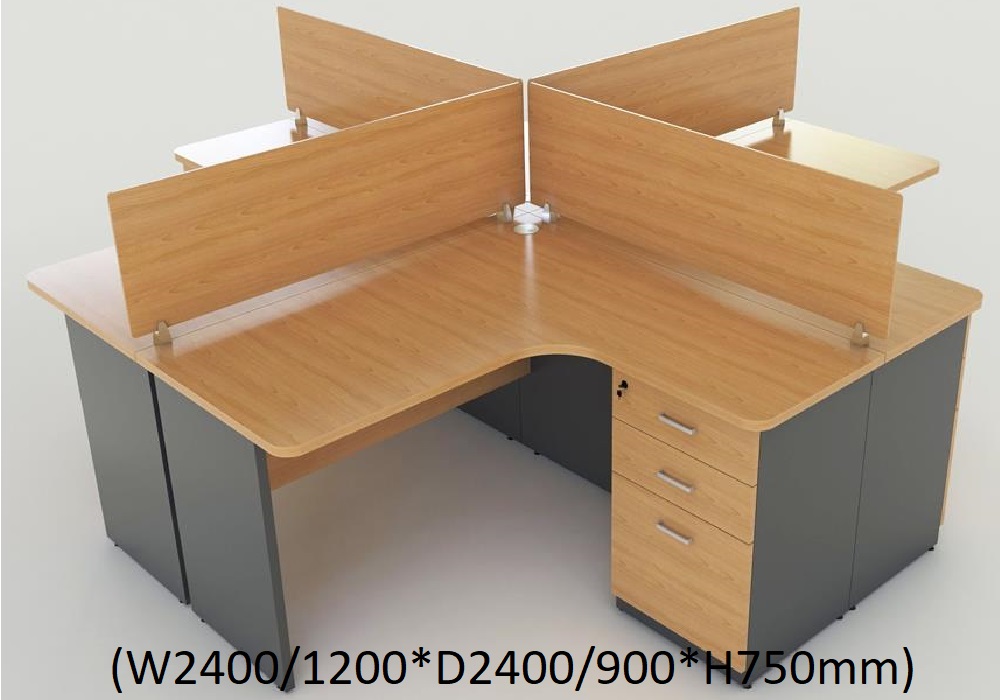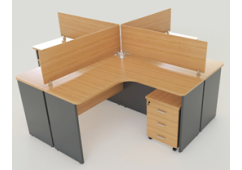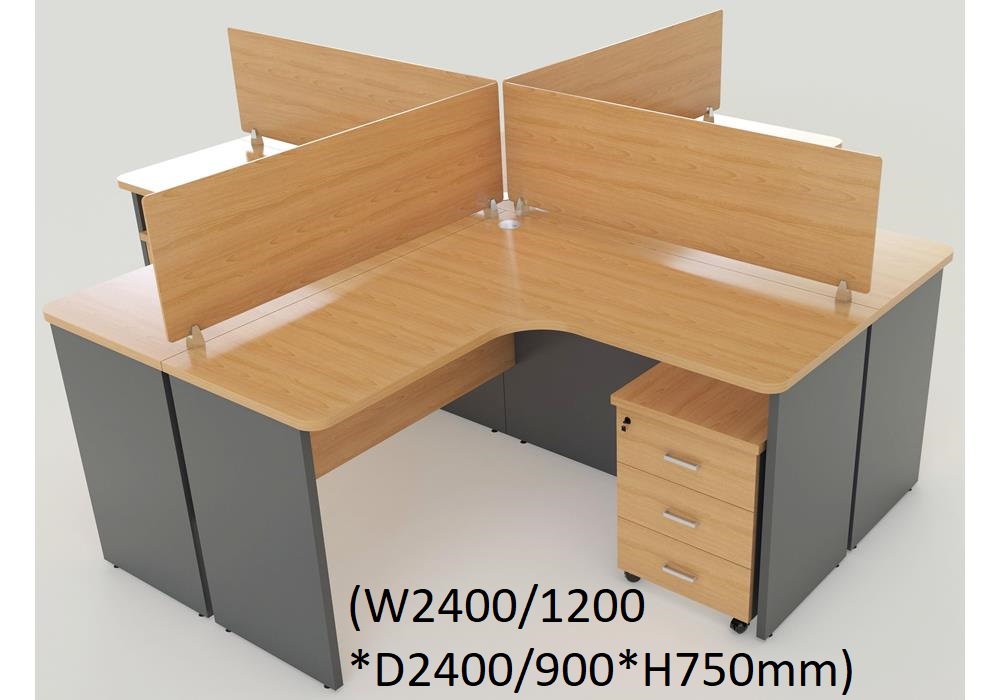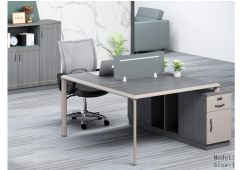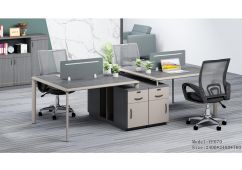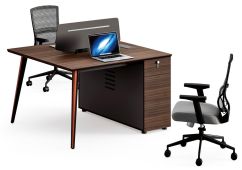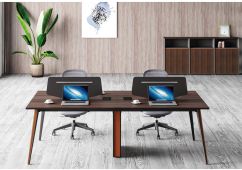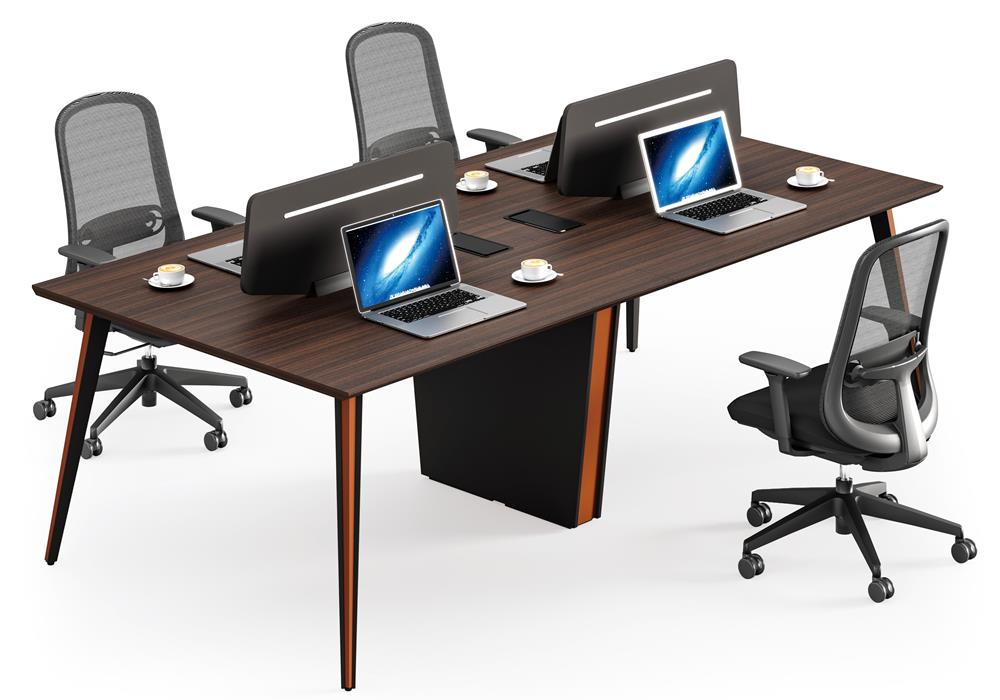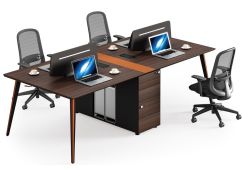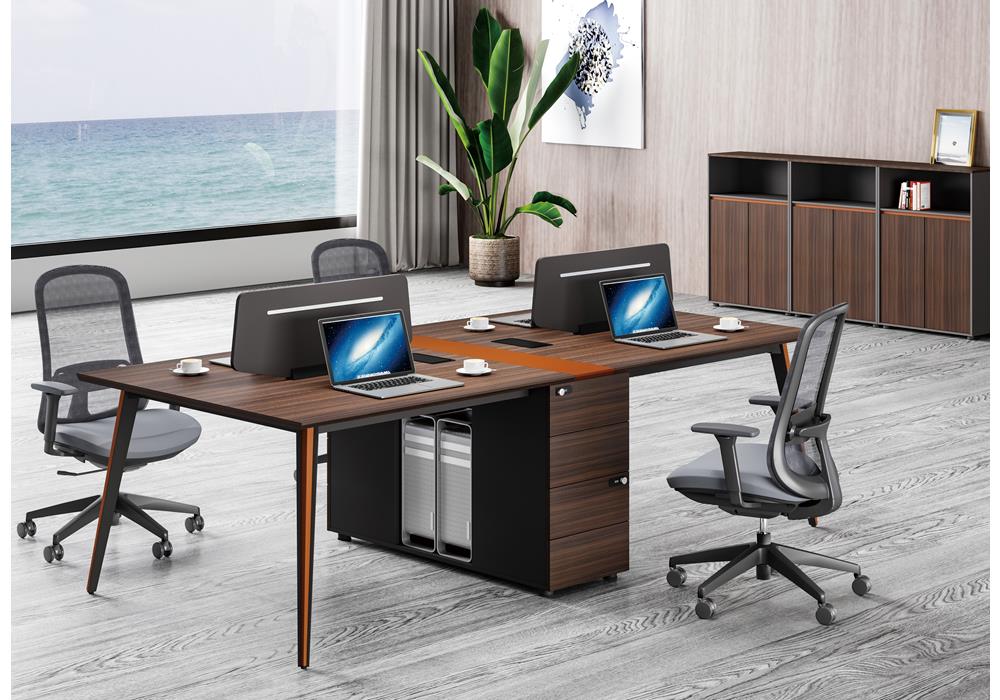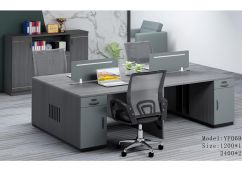What is a Workstation Table?
A workstation table is the cornerstone of any efficient workspace. It provides a dedicated surface for computers, laptops, paperwork, and essential office tools. Modern workstation tables come in various sizes, materials, and configurations, making them suitable for solo employees, collaborative teams, or open-plan offices. Here are some innovative tips for startup office setup.
Key Features of Workstation Tables:
- Robust Construction: Built to withstand daily use, ensuring longevity and stability.
- Ergonomic Design: Promotes healthy posture and minimizes physical strain for long working hours.
- Cable Management: Integrated solutions for organizing wires and keeping your workspace tidy.
- Adjustable Options: Height-adjustable and modular designs for flexible usage.
- Material Variety: Available in melamine, wood veneer, glass, and more for every aesthetic preference.
The Role of Office Workstations
Office workstations are more than just desks—they are comprehensive workspaces that foster productivity, organization, and employee well-being. A well-designed office workstation provides a personalized area for each employee, equipped with storage, ergonomic furniture, and technology integration making it smarter choices.
Benefits of Office Workstations:
- Personalized Workspace: Employees can organize tools, documents, and personal items for maximum efficiency and comfort.
- Enhanced Focus: Minimizes distractions, allowing for better concentration and higher quality work.
- Improved Ergonomics: Adjustable chairs, office desks, and monitor stands help maintain proper posture and reduce the risk of musculoskeletal disorders.
- Organization and Efficiency: Dedicated storage for files, stationery, and equipment keeps the workspace clutter-free and promotes productivity.
Why Choose Maricson Office Workstations: Beyond Ergonomics and Customization
Maricson office workstations are designed with a keen eye for both form and function, but several unique advantages set them apart from standard solutions—beyond ergonomics and customization.
- Global Quality Assurance: Maricson employs a dedicated team of quality inspectors who rigorously check every product before shipment, ensuring that every workstation meets international quality standards and customer expectations.
- Prompt and Reliable Delivery: With streamlined logistics and a commitment to customer satisfaction, Maricson is recognized for its prompt delivery times, helping businesses upgrade their workspaces quickly and efficiently.
- Versatile Aesthetic Options: Maricson offers a wide range of contemporary and classic designs, including sleek curves, glass elements, and modular units, so your workstation not only fits your workflow but also enhances the visual appeal of your office.
- Technology-Ready Workspaces: Maricson workstations are built to accommodate the latest office technology, with integrated cable management, easy access to power outlets, and options for smart device integration—future-proofing your workspace for evolving needs.
- Long-Term Value and Durability: Made from premium materials and engineered for daily use, Maricson workstations are a sound investment that maintains its appearance and functionality over time, reducing the need for frequent replacements.
By choosing Maricson, you benefit from a workstation solution that is not only ergonomic and customizable but also backed by quality assurance, reliable service, and a commitment to lasting value—helping your business thrive in a dynamic office environment.
Latest Trends in Workstation Design for 2025
As workspaces evolve, so do workstation designs. Here are the top trends shaping modern office workstations:
- Flexible and Hybrid-Friendly Workstations: Modular setups, movable partitions, and stackable furniture support hybrid work models and maximize space efficiency.
- Biophilic Design: Incorporating natural elements like plants, reclaimed wood, and cork to boost productivity and creativity.
- Smart Technology Integration: Built-in charging stations, USB ports, and wireless connectivity for seamless workflow.
- Sustainable Materials: Eco-friendly options for environmentally conscious organizations.
Choosing the Right Workstation Table
Selecting the ideal workstation table involves considering several factors:
- Size and Space: Ensure the table fits comfortably in your workspace and accommodates all necessary equipment.
- Material: Choose from durable options like melamine, wood veneer, or glass, each offering unique benefits in terms of durability, aesthetics, and maintenance.
- Ergonomic Features: Look for adjustable height, cable management, and ample legroom for long-term comfort.
- Storage Solutions: Opt for tables with drawers, shelves, or integrated storage to keep your workspace organized.
Why Choose Maricson for Your Workstation Needs?
At Maricson, we understand that every workspace is unique. Our workstation tables and office workstations are designed with the latest trends, ergonomic principles, and sustainability in mind. We offer:
- Customizable Solutions: Tailor your workstation to your specific requirements.
- Premium Quality: Durable materials and expert craftsmanship for long-lasting performance.
- Expert Advice: Our team is ready to help you select the perfect workstation for your office or home.
Upgrade your workspace today with Maricson's workstation solutions—where innovation meets comfort and efficiency.
Why Maricson Office Workstations are top choice?
Maricson office workstations stand out for their commitment to innovative design, premium craftsmanship, and tailored solutions that adapt to the evolving needs of modern workplaces. Unlike standard workstations, Maricson offers a unique blend of bespoke customization and advanced modularity, allowing you to create a workspace that truly reflects your company's identity and operational requirements.
- Bespoke Customization: Maricson specializes in custom-built solutions, enabling you to specify dimensions, finishes, and configurations that align with your office layout and brand aesthetics. Whether you need open-plan collaboration spaces or private cubicles, Maricson can deliver a workstation tailored to your exact needs.
- Advanced Modularity: The modular design of Maricson workstations ensures effortless reconfiguration as your team grows or your workflow changes. This flexibility supports agile work environments, making it easy to expand, rearrange, or upgrade your workspace without the need for extensive remodeling.
- Premium Materials and Durability: Maricson uses high-quality, durable materials that are built to withstand the demands of daily use while maintaining a sophisticated, professional appearance. This focus on quality ensures long-term value and a polished office environment.
- Seamless Integration of Technology: Maricson workstations are designed with modern technology in mind, featuring integrated cable management, easy access to power outlets, and options for built-in USB ports. These features help keep your workspace tidy and your devices powered throughout the day.
- Expert Support and Service: As a manufacturer and exporter with a strong reputation, Maricson provides expert guidance from initial design through installation, ensuring a smooth, hassle-free experience for businesses of all sizes.
Choosing Maricson office workstations means investing in a workspace that is not only ergonomic and stylish but also future-ready, adaptable, and uniquely yours.
What unique ergonomic features make Maricson workstations stand out for long-term comfort
When selecting an ergonomic office workstation, focus on features that maximize comfort, support proper posture, and reduce the risk of musculoskeletal disorders. Here are the key features to consider:
- Adjustable Desk Height: The desk should allow you to adjust its height so that your arms rest at a 90-degree angle when typing, and your feet remain flat on the floor. Sit-stand desks are especially beneficial for alternating between sitting and standing positions, which can improve circulation and reduce fatigue.
- Ergonomic Chair: Choose office chairs with adjustable seat height, depth, and lumbar support. The backrest should support the natural curve of your spine, and armrests should be adjustable to keep your shoulders relaxed. The seat should be padded for comfort and allow for a slight forward or backward tilt.
- Monitor Placement: Position the monitor at arm's length away, with the top of the screen at or slightly below eye level. This helps prevent neck strain and eye fatigue. Use a monitor arm or riser for easy adjustment and to maintain optimal viewing angles.
- Keyboard and Mouse Positioning: Place the keyboard and mouse close to your body and at elbow height to maintain a 90-degree elbow angle. This minimizes reaching and wrist strain. Consider a keyboard tray if needed to achieve the correct height.
- Footrest: If your feet do not rest comfortably on the floor, use a footrest to support your legs and improve circulation.
- Cable Management: Integrated cable management systems keep your workspace tidy and reduce clutter, which is important for both ergonomics and productivity.
- Lighting and Accessories: Ensure your workspace is well-lit (500–750 lux recommended) to reduce eye strain. Use ergonomic accessories such as wrist rests, laptop stands, and document holders as needed.
- Personalization and Mood: Add personal touches like plants or photos to enhance your mood and comfort, but keep your workstation uncluttered for efficiency.
By prioritizing these features, you can create an ergonomic office workstation that supports long-term health, comfort, and productivity.
How does changing postures at workstation every 30 minutes protect me from joint stress
Changing your posture every 30 minutes is a highly effective way to protect your joints from stress and reduce the risk of discomfort or injury. When you maintain a single posture for extended periods—whether sitting or standing—certain muscles, ligaments, and joints are subjected to continuous pressure and load, which can lead to muscle fatigue, joint stiffness, and even chronic pain over time.
By shifting your position regularly, you:
- Distribute Load Across Different Joints and Muscles: Each posture uses a slightly different combination of muscles and joints. Changing positions prevents any single area from bearing the brunt of your body's weight for too long, reducing abnormal wear and tear and the risk of joint overuse.
- Improve Circulation and Muscle Engagement: Movement stimulates blood flow, which helps deliver nutrients to your joints and muscles and removes waste products. This keeps your tissues healthier and more resilient.
- Reduce Muscle Fatigue and Stiffness: Regular changes in posture allow muscles to relax and recover, preventing them from becoming overtired or tight. This helps maintain flexibility and reduces the risk of injury.
- Support Proper Spinal Alignment: Frequent shifts encourage you to reset your posture, which helps keep your spine aligned and reduces stress on spinal discs and nerves.
In summary, changing your posture every 30 minutes helps you avoid sustained stress on any one joint or muscle group, supports joint health, and keeps you more comfortable and productive throughout your workday.
Which adjustable features are most crucial for customizing my ergonomic workstation
The most crucial adjustable features for customizing an ergonomic workstation are those that allow you to tailor your setup to your body and work style, reducing discomfort and the risk of injury. Here are the essential adjustable features to prioritize:
- Desk Height Adjustability: A desk that can be raised or lowered is fundamental, especially if you alternate between sitting and standing. This helps maintain proper alignment of your arms, shoulders, and eyes with your screen and keyboard, preventing strain and fatigue. Sit-stand desks with memory presets or smooth adjustment mechanisms are ideal for shared or multi-user environments.
- Chair Adjustments:
- Seat Height: Adjustable seat height ensures your feet are flat on the floor and your thighs are parallel to the ground.
- Seat Depth: Adjustable seat depth supports your thighs without pressure behind the knees, which is important for circulation and comfort.
- Lumbar Support: Adjustable lumbar support maintains the natural curve of your spine and reduces lower back strain.
- Armrests: Adjustable armrests support your arms at a comfortable height, reducing shoulder and neck tension.
- Backrest Angle: Adjustable backrest or reclining options promote dynamic sitting and reduce pressure points.
- Keyboard and Mouse Positioning: An adjustable keyboard tray allows you to position your keyboard and mouse at the correct height and angle, keeping your wrists in a neutral position and minimizing strain. The tray should be easy to move and lock into place for optimal ergonomics.
- Monitor Placement: Use an adjustable monitor arm or stand to position your screen at eye level and an arm's length away, preventing neck and eye strain. The ability to adjust monitor height, tilt, and distance is key for long-term comfort.
- Footrest (if needed): If your feet don't comfortably reach the floor, an adjustable footrest can provide support and improve circulation.
Customizing these features ensures your workstation is tailored to your body, work habits, and comfort, making your workspace both ergonomic and productive.
How does height adjustability impact my comfort during long work hours at workstation
Height adjustability is a crucial feature for comfort during long work hours because it allows you to customize your workstation to fit your body and preferred working style. When you can adjust the height of your desk and chair, you can maintain proper posture—keeping your feet flat on the floor, your knees at a 90-degree angle, and your arms at a comfortable level relative to your desk. This alignment reduces strain on your back, neck, and shoulders, which are common sources of discomfort during prolonged sitting.
By alternating between sitting and standing with a height-adjustable desk, you also promote better spinal alignment and reduce the risk of musculoskeletal issues. This flexibility helps you avoid the fatigue and stiffness associated with staying in one position for too long, keeping you more energized and focused throughout the day. Studies show that workers using height-adjustable desks report less back and neck pain, improved posture, and higher energy levels, all of which contribute to greater comfort and productivity during extended work sessions.
How does switching between sitting and standing improve my comfort long-term with workstations
Switching between sitting and standing at your workstation improves your long-term comfort by addressing several common issues associated with prolonged static postures. Here's how it benefits you:
- Reduces Back and Neck Pain: Alternating positions helps alleviate pressure on your spine, reducing the likelihood of chronic discomfort in your back and neck. Prolonged sitting can compress spinal discs and muscles, but standing relieves this pressure and distributes your weight more evenly.
- Improves Posture: Standing encourages you to maintain a more natural spinal alignment and engage your core muscles, which supports your back and reduces slouching. Over time, this leads to better posture and less strain on your musculoskeletal system.
- Enhances Circulation and Reduces Fatigue: Moving between sitting and standing promotes better blood flow, which reduces swelling in the legs and feet and helps you feel more energized throughout the day. This can also help prevent the sluggishness and fatigue often felt after long hours at a desk.
- Supports Weight Management and Metabolic Health: Standing for part of the day increases your energy expenditure, helping you burn more calories and supporting better metabolic health. This can contribute to long-term benefits such as reduced risk of obesity, type 2 diabetes, and cardiovascular disease.
- Encourages Movement and Flexibility: Switching positions allows for more movement, stretching, and shifting your weight, which keeps your joints and muscles from becoming stiff or sore. This flexibility helps maintain joint health and overall comfort over time.
By regularly alternating between sitting and standing, you create a more dynamic and ergonomic work environment, which supports your physical health, comfort, and productivity in the long run. It's recommended to transition gradually and find a balance that works for your body and work style.
How does alternating sitting and standing at office workstation prevent long-term back pain
Alternating between sitting and standing at your workstation helps prevent long-term back pain by addressing the main causes of discomfort associated with static postures. Prolonged sitting increases pressure on the intervertebral discs, especially in the lumbar region, and can weaken trunk muscles, disrupt spinal curvature, and lead to muscle imbalances and chronic pain. Standing for extended periods also poses risks, such as increased stress on the lower back and joints, and can cause fatigue and discomfort.
By regularly switching positions, you reduce continuous pressure on the same structures—such as discs, muscles, and joints—and allow for better blood circulation and muscle engagement. Studies show that this alternation is associated with increased trunk stiffness and reduced back muscle activity compared to staying in one position, which may help alleviate and prevent low back pain. Movement breaks and postural changes also help maintain spinal health, prevent muscle fatigue, and reduce the likelihood of developing chronic pain.
In summary, alternating sitting and standing distributes stress more evenly across your body, keeps muscles active, and supports the natural curves of your spine, all of which help prevent long-term back pain.
How does alternating sitting and standing at workstations reduce disc pressure on my spine
Alternating between sitting and standing at your workstation reduces disc pressure on your spine by minimizing the prolonged stress that either posture alone can cause. When you sit, especially with poor posture or for long periods, your pelvis tilts backward, flattening the natural curve in your lower back and increasing pressure on the intervertebral discs—sometimes by more than 20–40% compared to standing, according to older studies. This increased pressure can contribute to disc degeneration and discomfort.
Standing, on the other hand, helps restore the natural lordotic (inward) curve of the lumbar spine and distributes your body weight more evenly. However, standing for too long can also place stress on the spine and joints. By alternating between sitting and standing, you avoid maintaining a single posture for extended periods, which helps:
- Distribute Stress: Shifting positions distributes the load across different parts of your spine, reducing the risk of overloading any single disc or muscle group.
- Promote Movement: Frequent changes in posture encourage movement, which improves circulation and the transport of nutrients to spinal discs, helping to maintain their health.
- Prevent Stiffness and Muscle Fatigue: Movement keeps your muscles active and reduces stiffness, which is important for supporting your spine and preventing pain.
In summary, alternating sitting and standing reduces sustained disc pressure, supports spinal health, and helps prevent long-term back problems by promoting movement and a more balanced load on your spine.
Frequently Asked Questions (FAQs) on Maricson Workstations
Q1: What quality assurance processes does Maricson follow for its workstations?
Maricson implements rigorous quality checks at every stage of production, including material inspection, craftsmanship assessment, and final pre-shipment quality control, ensuring each workstation meets high international standards.
How does Maricson ensure timely delivery of office workstations?
Maricson has a dedicated logistics team and streamlined shipping processes to guarantee prompt and reliable delivery, minimizing downtime for your office upgrade.
Q3: What design options are available for Maricson workstations?
Maricson offers a diverse range of design options, including modern curves, glass accents, modular layouts, and a variety of finishes to suit any office style and brand identity.
Q4: Are Maricson workstations compatible with the latest office technology?
Yes, Maricson workstations are designed with integrated cable management, easy access to power outlets, and options for smart device integration, making them ready for current and future technology needs.
Q5: How do Maricson workstations support long-term value and durability?
Maricson uses premium, durable materials and advanced construction techniques to ensure workstations remain functional and attractive for years, reducing the need for frequent replacements.

